Upwards movement continues as expected from last analysis. The target remains the same.
Summary: Expect upwards movement this week. The target is now a range within 2,752 – 2,766. When there is more upwards structure to analyse, then a smaller target may be calculated.
Some small support today from volume and bullish divergence with the AD line support the idea of more upwards movement tomorrow.
Do not expect this upwards swing to move in a straight line. Look out for a pullback for a B wave within it.
Always practice good risk management. Always trade with stops and invest only 1-5% of equity on any one trade.
New updates to this analysis are in bold.
The biggest picture, Grand Super Cycle analysis, is here.
Last historic analysis with monthly charts is here. Video is here.
An alternate idea at the monthly chart level is given here at the end of this analysis.
An historic example of a cycle degree fifth wave is given at the end of the analysis here.
MAIN ELLIOTT WAVE COUNT
WEEKLY CHART
Cycle wave V must complete as a five structure, which should look clear at the weekly chart level. It may only be an impulse or ending diagonal. At this stage, it is clear it is an impulse.
Within cycle wave V, the third waves at all degrees may only subdivide as impulses.
Intermediate wave (4) has breached an Elliott channel drawn using Elliott’s first technique. The channel is redrawn using Elliott’s second technique as if intermediate wave (4) was over at the first swing low within it. If intermediate wave (4) continues sideways, then the channel may be redrawn when it is over. The upper edge may provide resistance for intermediate wave (5).
Intermediate wave (4) may not move into intermediate wave (1) price territory below 2,193.81. However, it would be extremely likely to remain within the wider teal channel (copied over from the monthly chart) if it were to be reasonably deep. This channel contains the entire bull market since the low in March 2009, with only two small overshoots at the end of cycle wave IV. If this channel is breached, then the idea of cycle wave V continuing higher would be discarded well before the invalidation point is breached.
At this stage, it now looks like intermediate wave (4) may be continuing further sideways as a combination, triangle or flat. These three ideas are separated into separate daily charts. All three ideas would see intermediate wave (4) exhibit alternation in structure with the double zigzag of intermediate wave (2).
A double zigzag would also be possible for intermediate wave (4), but because intermediate wave (2) was a double zigzag this is the least likely structure for intermediate wave (4) to be. Alternation should be expected until price proves otherwise.
DAILY CHART – TRIANGLE
This first daily chart looks at a triangle structure for intermediate wave (4). The triangle may be either a regular contracting or regular barrier triangle. Within the triangle, minor waves A, B and C may be complete.
If intermediate wave (4) is a regular contracting triangle, the most common type, then minor wave D may not move beyond the end of minor wave B above 2,801.90. Minor wave D would be very likely to end about 0.80 to 0.85 the length of minor wave C.
If intermediate wave (4) is a regular barrier triangle, then minor wave D may end about the same level as minor wave B at 2,801.90. As long as the B-D trend line remains essentially flat a triangle will remain valid. In practice, this means the minor wave D can end slightly above 2,801.90 as this rule is subjective.
When a zigzag upwards for minor wave D is complete, then this wave count would expect a final smaller zigzag downwards for minor wave E, which would most likely fall reasonably short of the A-C trend line.
If this all takes a further four weeks to complete, then intermediate wave (4) may total a Fibonacci 13 weeks and would be just two weeks longer in duration than intermediate wave (2). There would be very good proportion between intermediate waves (2) and (4), which would give the wave count the right look.
The lower wick of the candlestick for the 2nd of April overshoots the black channel and the 200 day moving average. This is entirely acceptable for this wave count; the overshoot does not mean price must now continue lower. The A-C trend line for this wave count should have a slope, so minor wave C should now be over.
HOURLY CHART
Minor wave D should subdivide as a zigzag, and within the zigzag minute wave b, when it arrives, should show up on the daily chart as one or more red daily candlesticks or doji. This should be a pullback within the upwards swing.
So far, within minor wave D, a five up looks incomplete for minute wave a. Within minute wave a, minuette waves (i) and (ii) may be complete. Minuette wave (ii) may have moved lower to begin this trading session as an expanded flat correction.
Minuette wave (iii) must subdivide as a five wave impulse, and within it subminuette wave iv may not move into subminuette wave i price territory below 2,620.11. The small orange Elliott channel is drawn about minuette wave (iii), but this channel has too steep a slope for any reasonable technical significance; it is a very short term channel only. When it is breached by downwards movement, that may be an indication that minuette wave (iii) may be over. At that stage, the higher invalidation point for subminuette wave iv will no longer apply, so use the lower invalidation point for minuette wave (iv) at 2,606.99. When minuette wave (iv) unfolds, it may not move back down into minuette wave (i) price territory.
When minute wave a is a complete five wave structure, then a multi day pullback for minute wave b may be expected. When both minute waves a and b are complete, then a smaller target for minute wave c to end minor wave D may be calculated using the Fibonacci ratios between minute waves a and c. That cannot be done yet.
ALTERNATE HOURLY CHART
It is possible that the second zigzag of minute wave y is incomplete.
Within minute wave y, minuette wave (c) may be an ending expanding diagonal. The diagonal may be expanding because subminuette wave iii is longer than subminuette wave i.
Subminuette wave iv is now longer than subminuette wave ii. Subminuette wave v must be longer than subminuette wave iii, so it must end below 2,544.49 where it would reach equality in length with subminuette wave iii.
Subminuette wave iv may not move beyond the end of subminuette wave ii above 2,569.07.
DAILY CHART – COMBINATION
Double combinations are very common structures. The first structure in a possible double combination for intermediate wave (4) would be a complete zigzag labelled minor wave W. The double should be joined by a three in the opposite direction labelled minor wave X, which may be a complete zigzag. X waves within combinations are typically very deep; if minor wave X is over at the last high, then it would be a 0.79 length of minor wave W, which is fairly deep giving it a normal look. There is no minimum nor maximum requirement for X waves within combinations.
The second structure in the double would most likely be a flat correction labelled minor wave Y. It may also be a triangle, but in my experience this is very rare, so it will not be expected. The much more common flat for minor wave Y will be charted and expected.
A flat correction would subdivide 3-3-5. Minute wave a must be a three wave structure, most likely a zigzag. It may also be a double zigzag. On the hourly chart, this is now how this downwards movement fits best, and this will now be how it is labelled.
Minute wave b must now reach a minimum 0.90 length of minute wave a. Minute wave b must be a corrective structure. It may be any corrective structure. It may be unfolding as an expanded flat correction.
The purpose of combinations is to take up time and move price sideways. To achieve this purpose the second structure in the double usually ends close to the same level as the first. Minor wave Y would be expected to end about the same level as minor wave W at 2,532.69. This would require a strong overshoot or breach of the 200 day moving average, which looks unlikely.
DAILY CHART – COMBINATION II
This is another way to label the combination.
Minor wave W is still a zigzag labelled in the same way, over at the first low within intermediate wave (4).
The double is joined by a quick three in the opposite direction labelled minor wave X, subdividing as a zigzag.
Minor wave Y may have begun earlier and may be an almost complete expanded flat correction, and within it minute wave a is a three, itself an expanded flat. Minute wave b is a zigzag and only slightly longer than the most common length of up to 1.38 times the length of minute wave a. Minute wave c downwards must be a five wave structure. It may need a final fifth wave to complete it.
Within minuette wave (v), no second wave correction may move beyond its start above 2,674.78.
The target would see minor wave Y end only slightly below the end of minor wave W. The whole structure for the double combination would move sideways. This wave count would also require a substantial breach of the 200 day moving average (at this point about 68 points). This is possible and does have precedent.
HOURLY CHART – COMBINATION II
The Elliott channel is drawn using Elliott’s second technique for an impulse. If an impulse downwards is incomplete, then within minuette wave (v) upwards corrections should find strong resistance at the upper edge of the channel. That channel should not be breached. The fact that it is breached must reduce the probability of this wave count.
Minuette wave (v) may be an incomplete ending expanding diagonal. The short term invalidation point and short term structure is the same as the alternate hourly chart above.
DAILY CHART – FLAT
Flat corrections are very common. The most common type of flat is an expanded flat. This would see minor wave B move above the start of minor wave A at 2,872.87.
Within a flat correction, minor wave B must retrace a minimum 0.9 length of minor wave A at 2,838.85. The most common length for minor wave B within a flat correction would be 1 to 1.38 times the length of minor wave A at 2,872.87 to 3,002.15. An expanded flat would see minor wave B 1.05 times the length of minor wave A or longer, at 2,889.89 or above.
Minor wave B may be a regular flat correction, and within it minute wave a may have been a single zigzag and minute wave b may have been a double zigzag. This has a very good fit. The subdivisions at the hourly chart level at this stage would be the same for the last wave down as the main wave count.
This wave count would require a very substantial breach of the 200 day moving average for the end of intermediate wave (4). This is possible but may be less likely than a smaller breach.
DAILY CHART – ALTERNATE
It is possible still that intermediate wave (4) was complete as a relatively brief and shallow single zigzag.
A new all time high with support from volume and any one of a bullish signal from On Balance Volume or the AD line would see this alternate wave count become the main wave count.
The target for minor wave 3 expects the most common Fibonacci ratio to minor wave 1.
Within minor wave 2, there is a truncation as noted on the chart. This must necessarily reduce the probability of this wave count.
Minor wave 2 may not move beyond the start of minor wave 1 below 2,532.69.
TECHNICAL ANALYSIS
WEEKLY CHART
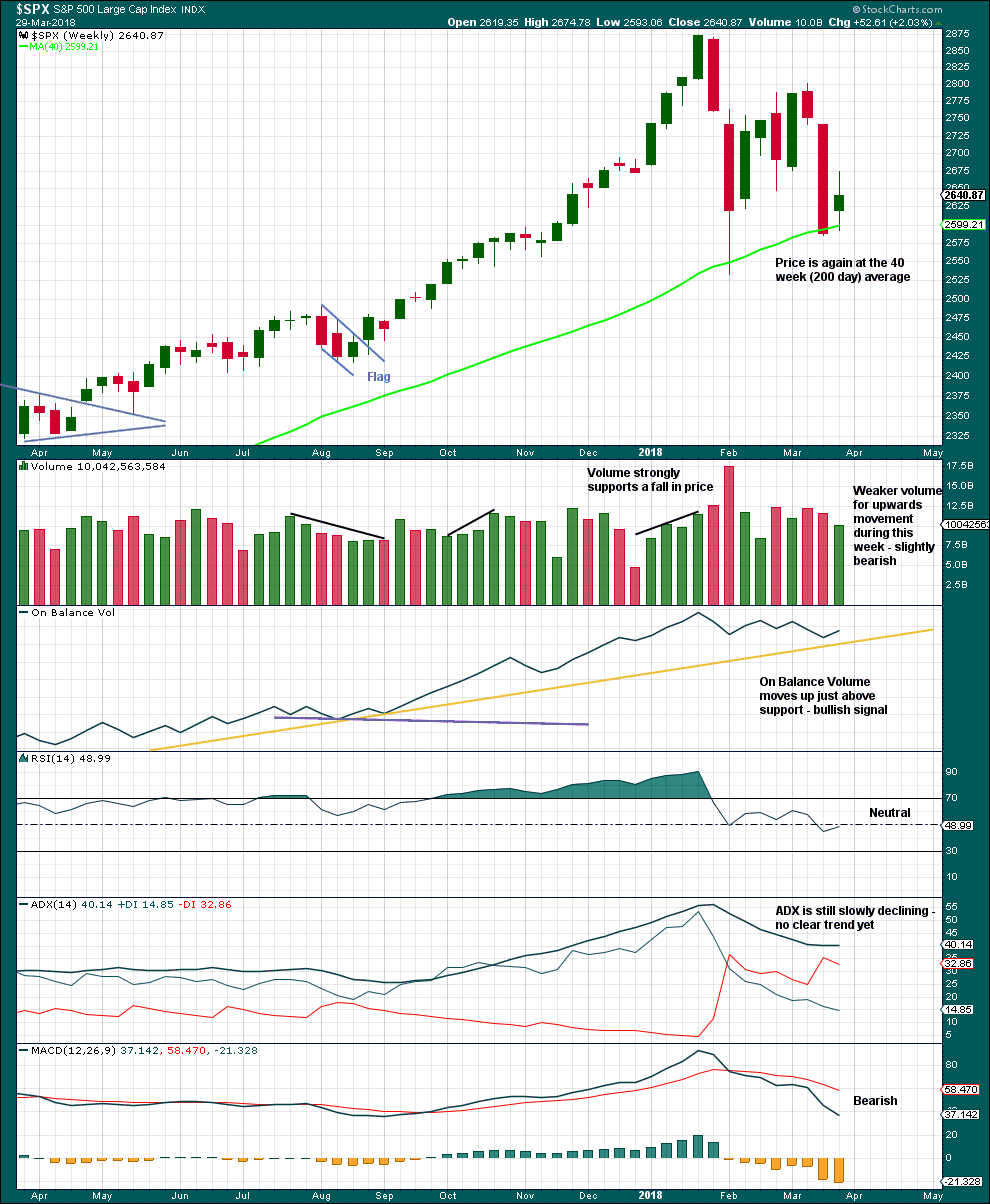
Click chart to enlarge. Chart courtesy of StockCharts.com.
Although volume last week is lighter than last two downwards weeks, this is only of slight concern. Light and declining volume has long been a feature of this bull market. It does not appear to be causing the bull market to be unsustainable, yet.
Give reasonable weight to the bullish signal from On Balance Volume, although it has not perfectly touched the support line.
It is a reasonable approach to expect the 200 day / 40 week moving average to continue to provide strong support while price is above it. Price has overshot the 200 day moving average and now returned above it. If this current week closes back above the average, then it may be expected that this area continues to provide support.
DAILY CHART
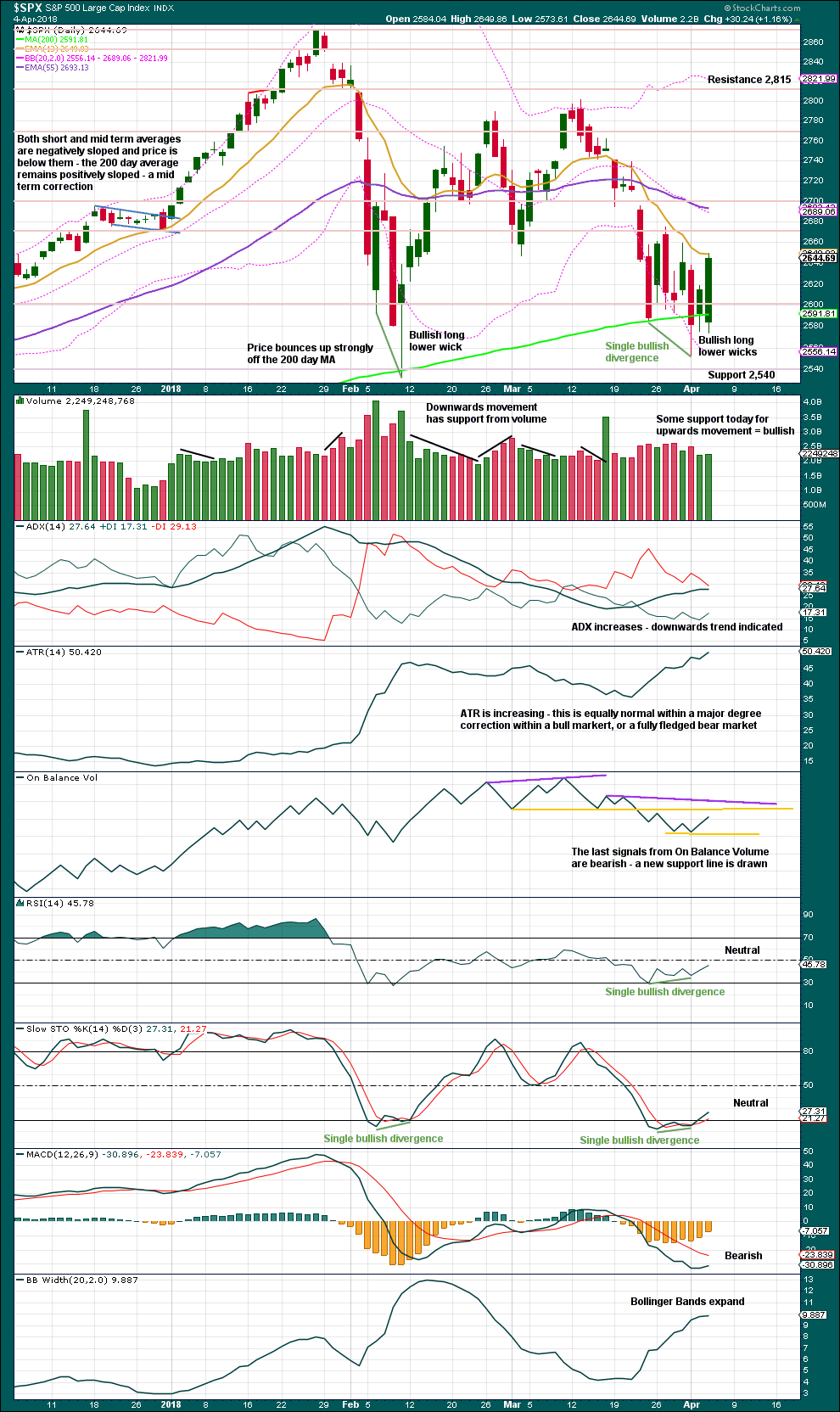
Click chart to enlarge. Chart courtesy of StockCharts.com.
A strong bullish daily candlestick with some support now from volume indicates more upwards movement ahead. Look for On Balance Volume to halt a rise in price; this may be where a pullback within an upwards swing begins.
VOLATILITY – INVERTED VIX CHART
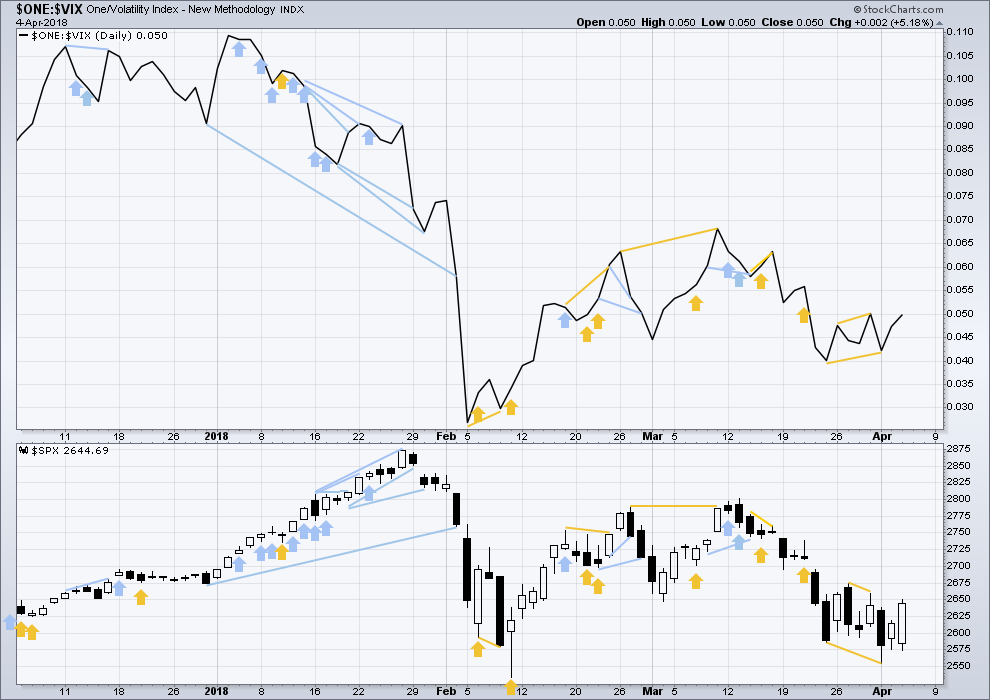
Click chart to enlarge. Chart courtesy of StockCharts.com.
So that colour blind members are included, bearish signals will be noted with blue and bullish signals with yellow.
Normally, volatility should decline as price moves higher and increase as price moves lower. This means that normally inverted VIX should move in the same direction as price.
Most recent bullish divergence has now been followed by two upwards days. It may be resolved here. There is no new divergence today.
BREADTH – AD LINE
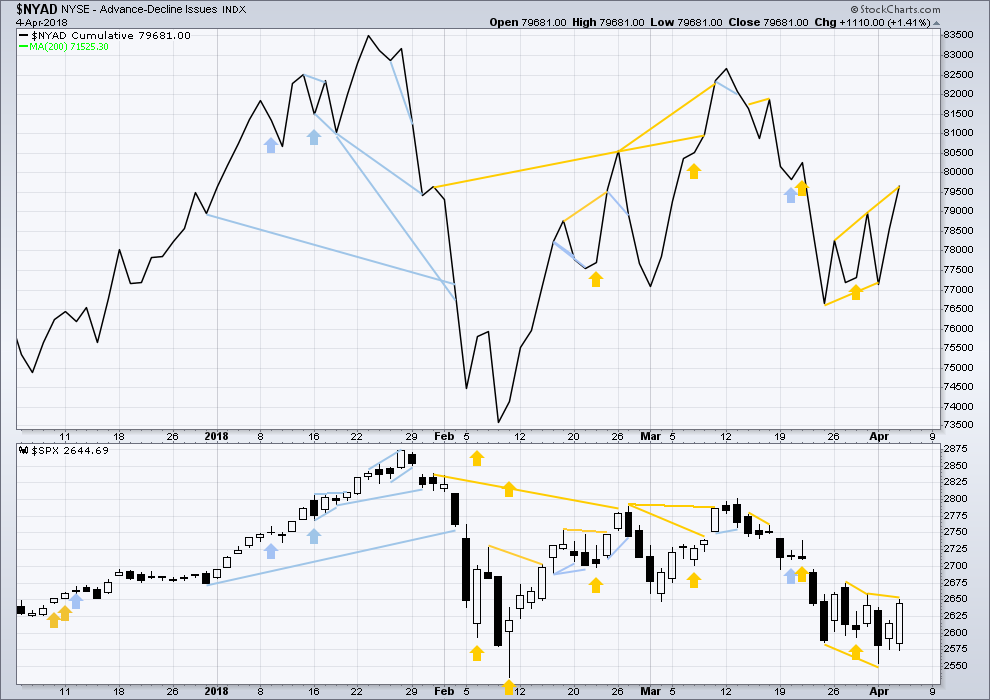
Click chart to enlarge. Chart courtesy of StockCharts.com.
There is normally 4-6 months divergence between price and market breadth prior to a full fledged bear market. This has been so for all major bear markets within the last 90 odd years. With no longer term divergence yet at this point, any decline in price should be expected to be a pullback within an ongoing bull market and not necessarily the start of a bear market.
All of small, mid and large caps last week fell strongly. The fall in price has broad support from market breadth. It was small caps though that had the least decline. This slight divergence indicates some weakness and may be interpreted as slightly bullish.
Breadth should be read as a leading indicator.
Most recent bullish divergence has now been followed by two upwards days. It may be resolved here. The AD line today has made a new small swing high, but price has not. This divergence is bullish.
DOW THEORY
The following lows need to be exceeded for Dow Theory to confirm the end of the bull market and a change to a bear market:
DJIA: 23,360.29.
DJT: 9,806.79.
S&P500: 2,532.69.
Nasdaq: 6,630.67.
Charts showing each prior major swing low used for Dow Theory may be seen at the end of this analysis here.
Published @ 10:12 p.m. EST.

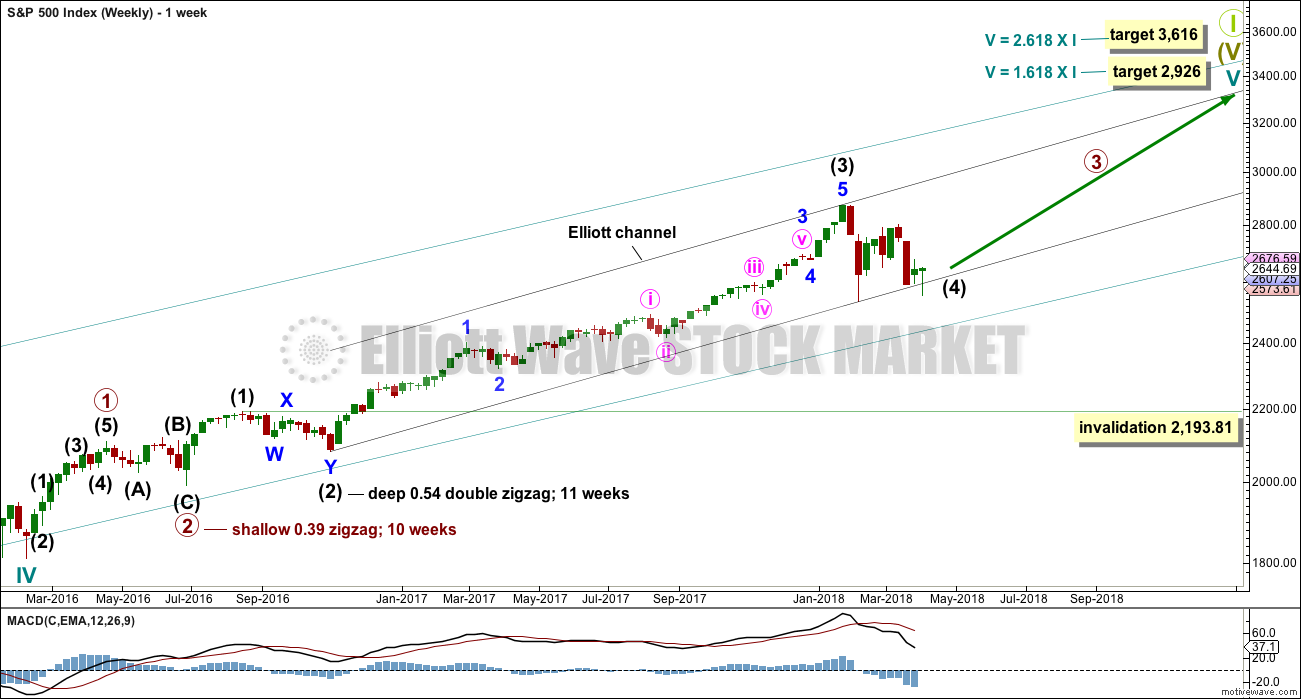
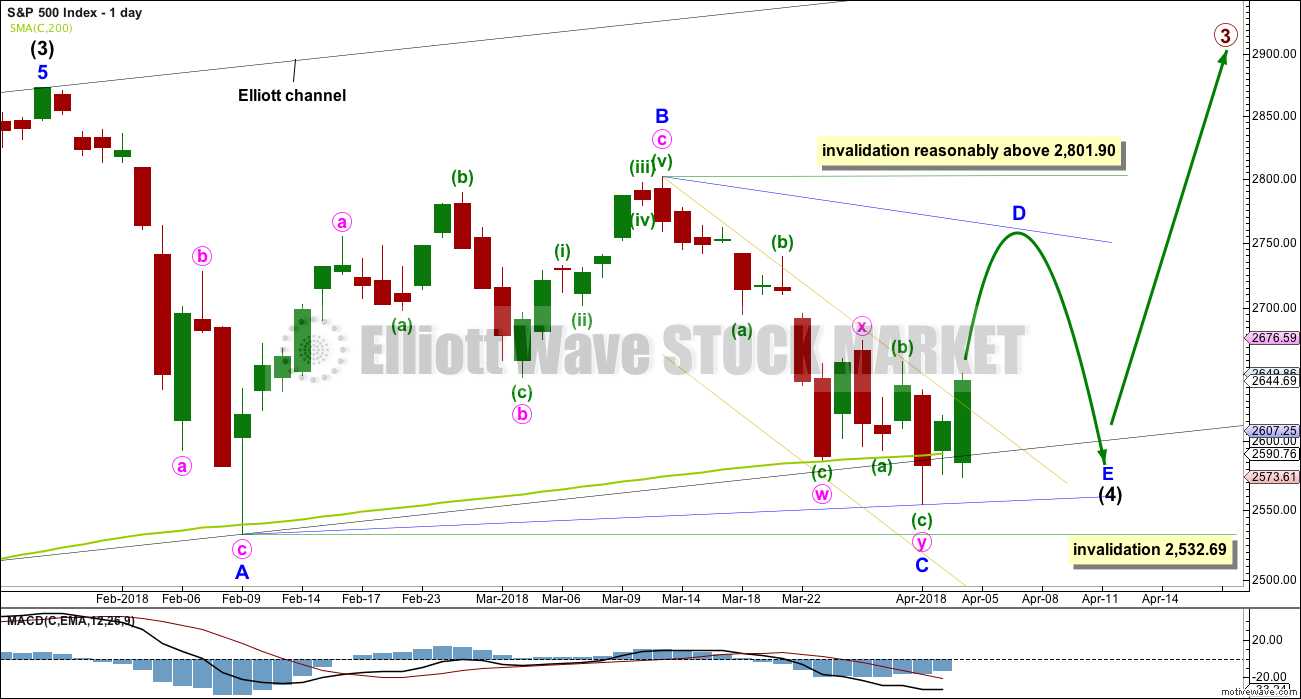
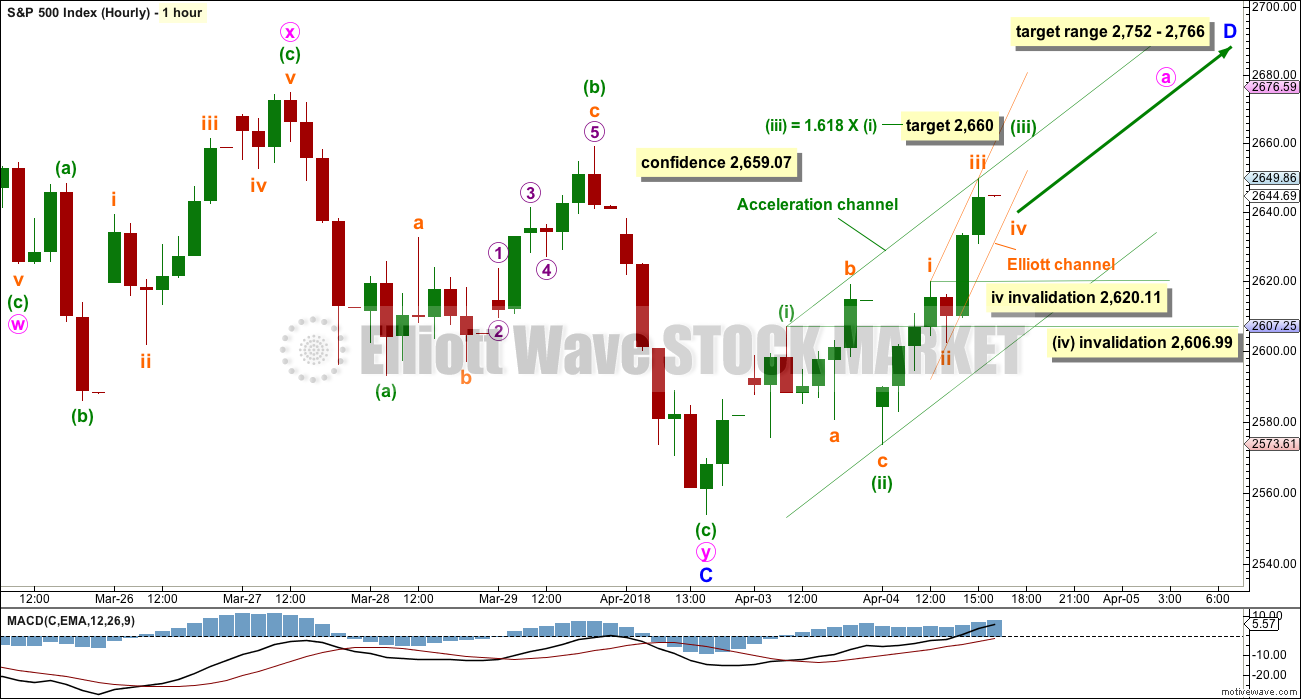
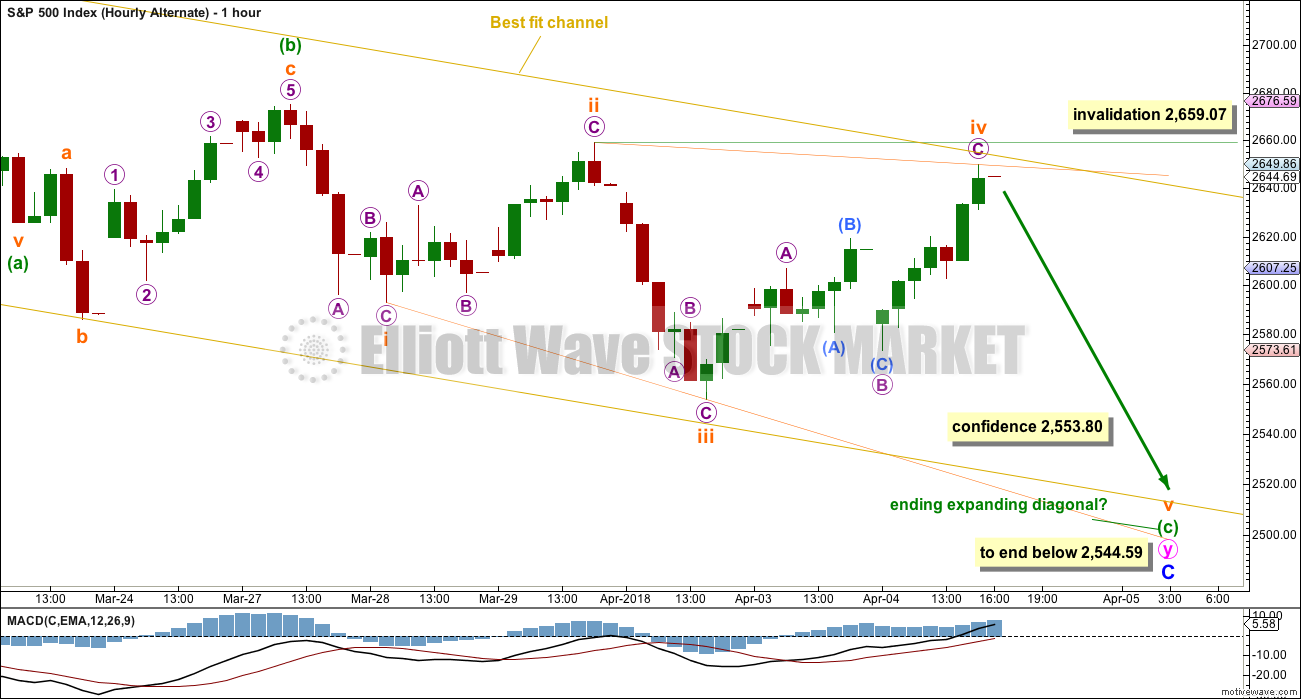
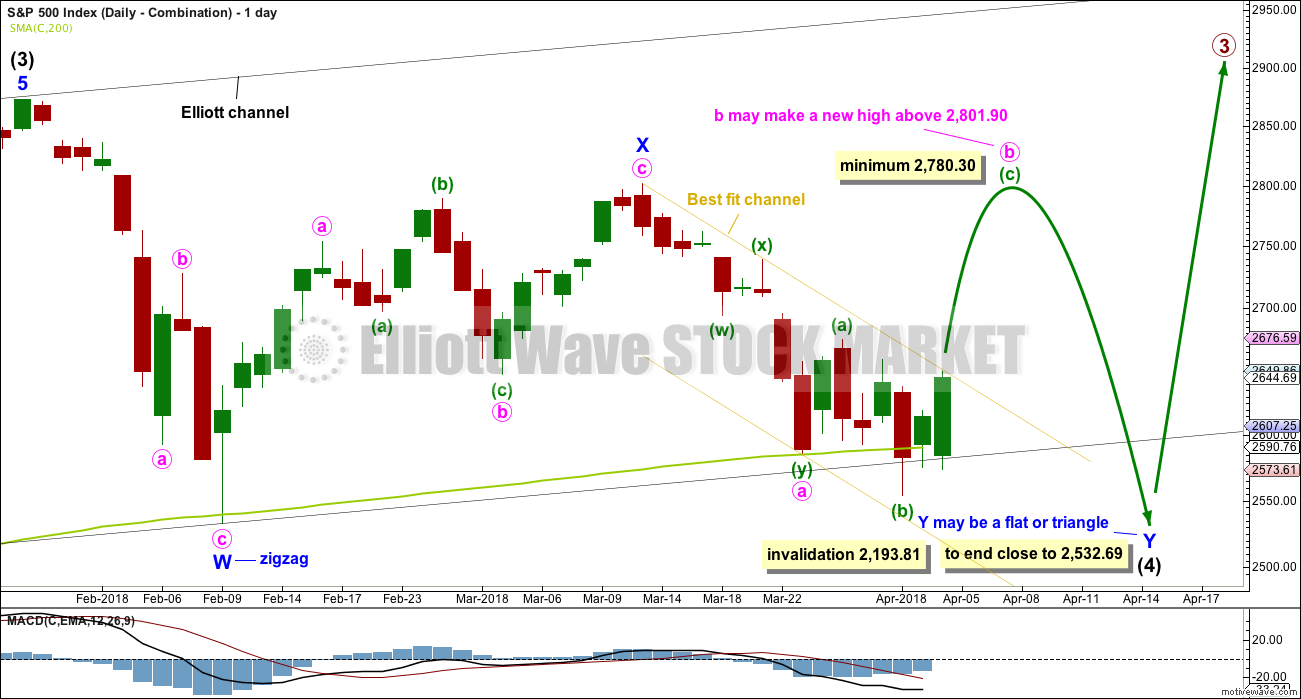
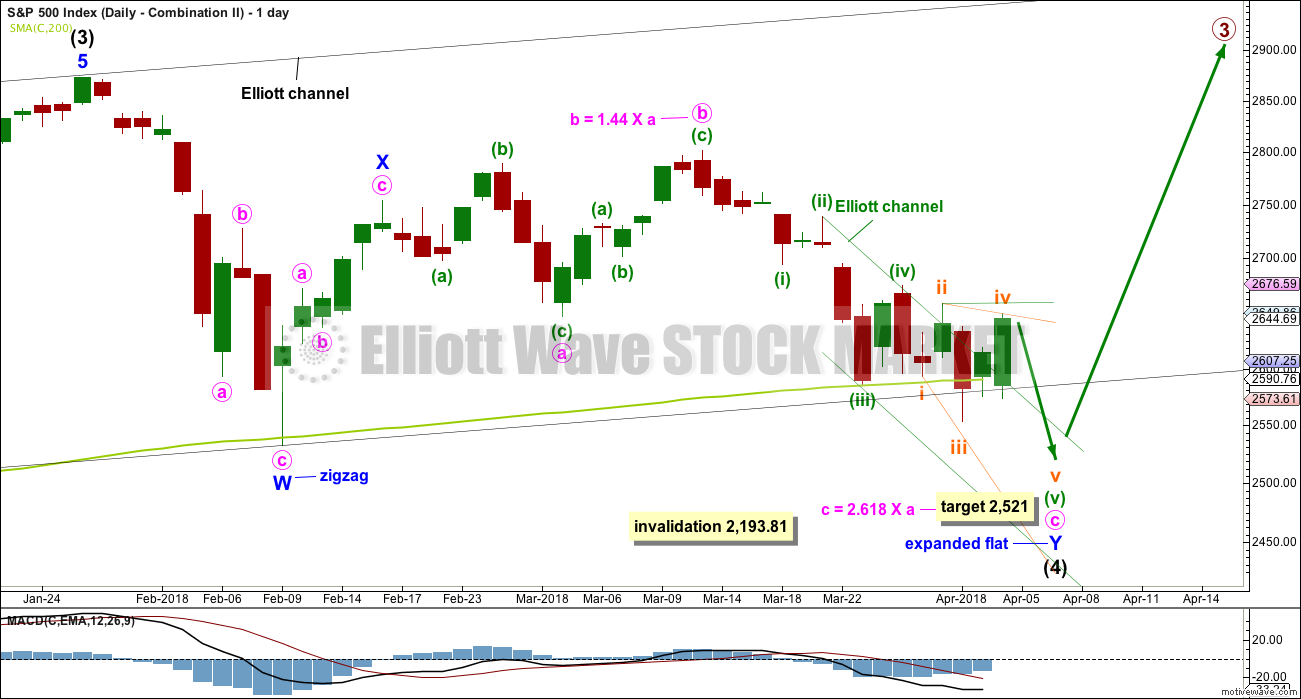
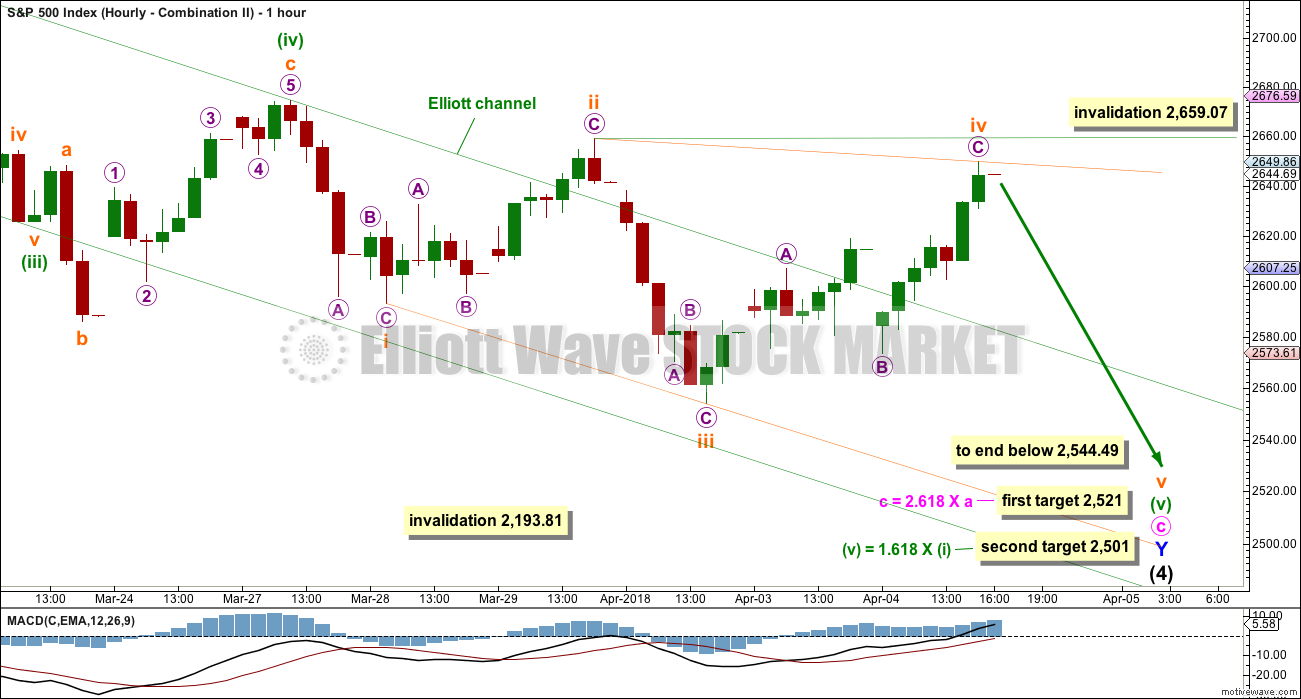
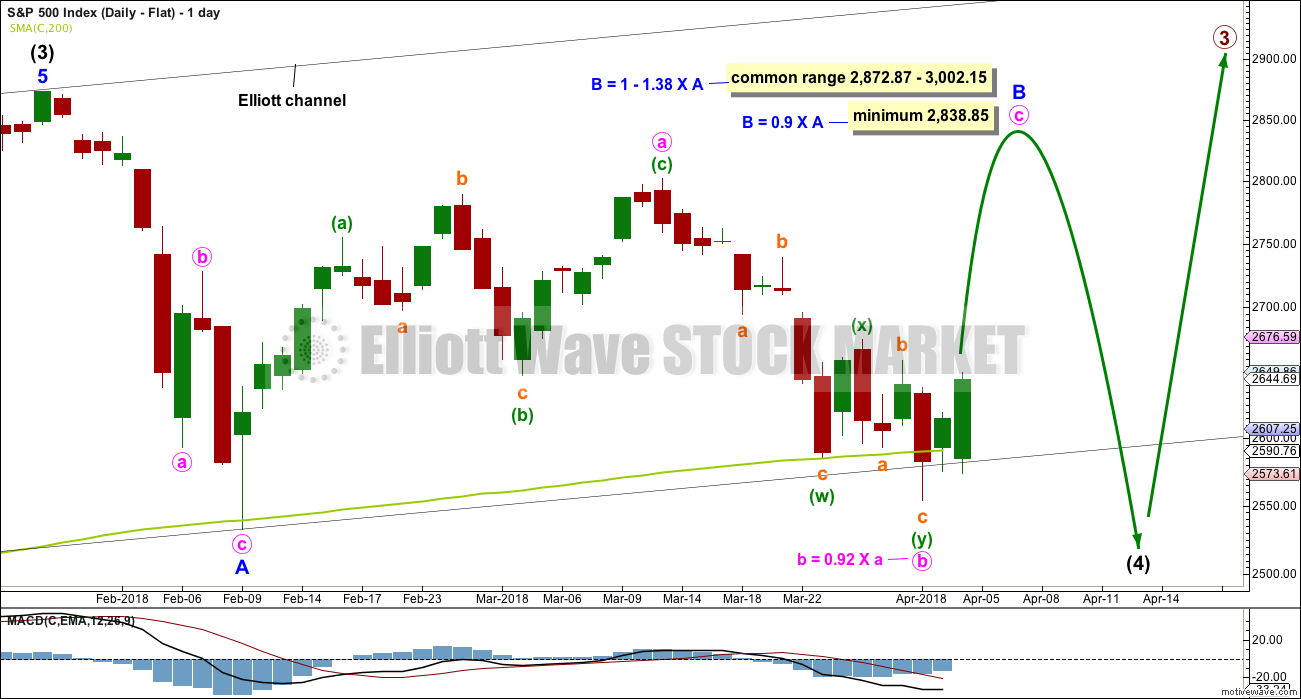
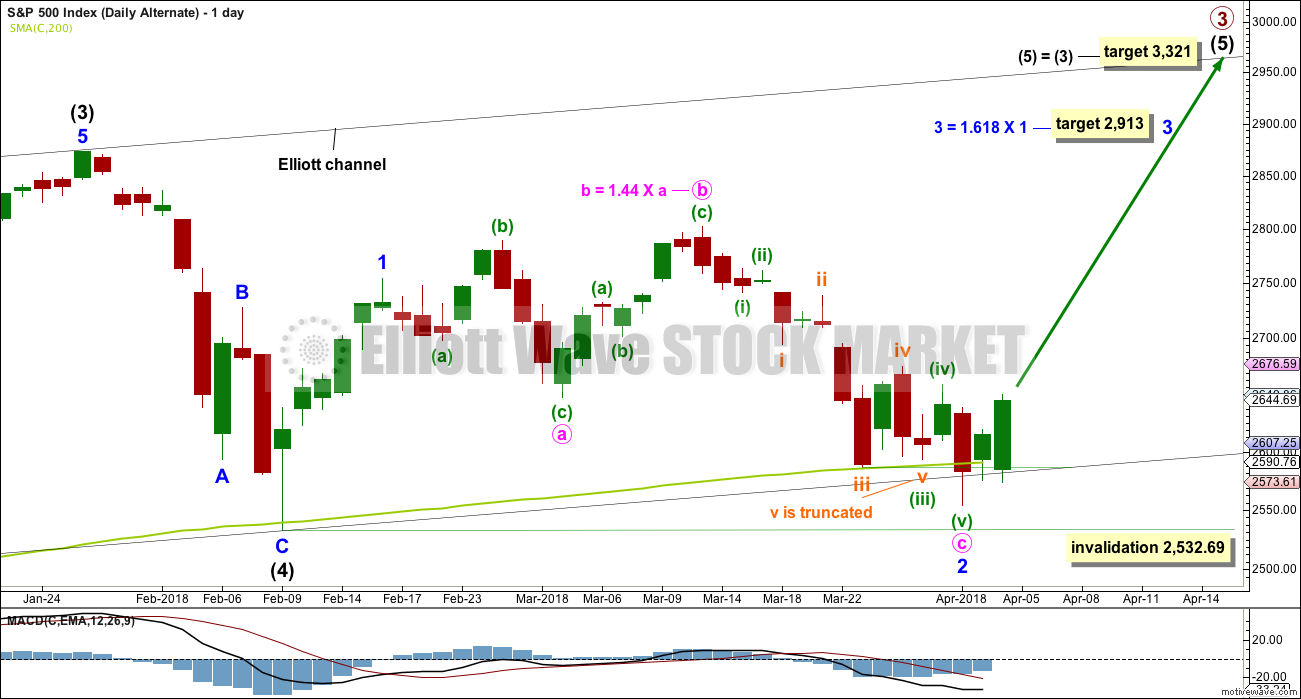
I think there’s a little more downwards movement here for minuette (iv).
For alternation with minuette (ii): expect it to be shallow in relation to minuette (iii), close to the 0.382 Fibonacci ratio at 2,634. Expect it to most likely be a single or double zigzag. It may not be as deep as the 0.382 ratio though, it may find good support at the lower edge of the Elliott channel.
After it’s done, more upwards movement.
The new high today above 2,659.07 invalidates the idea of minor C continuing lower. We can now have more confidence in an upwards swing continuing here, but again, don’t expect it to move in a straight line.
I appreciate these afternoon updates, Lara. Thank you so much!
Agreed, updates just before close are great for buy, sell, hold decision.
You’re welcome guys.
Thanks Lara.
TD Ameritrade offered an olive branch today with a refund of the cost of my wire and a basket of free trades.
Thinking about it… 🙂
hourly main holding so far this morning…very nice! a 50% fibo and a recent high above at 2676, next stop the 62% around 2704. I’m seeing this sideways action as the subminuette 4, with a subminuette 5 coming very soon to complete the minuette 3. Let’s see…nothing would in fact surprise me, including a sudden and massive sell off. This market is a bit wild and wholly right now.
agreed!
Was that a small subminuette 5 and now the minuette 4 is starting? I’ve taken the profits across my board and have established a tiny short…just below the 50% and recent high seems like a perfectly natural place for this market to turn and breath for a bit.
Hi Kevin
What about the triangle?
What about this just being a 4th wave churning?
Please share
Thank You
yes this minuette 4 could triangle out, but as Lara says, “there are 23 possible corrective patterns”, so ???
If it keeps pushing down I’ll be watching 2645-47 closely for a turn. that’s the 38% retrace back down of the 3 wave up, and other older fibo’s there too.
I have two cluster areas of fibos one in the 45-47 zone and another in the 35-38 zone. Both are high potential turn areas.
did we turn back up here ?
could be abc down now complete. or…could be a small 5 wave move down, a 3 wave “b” up now in progress, and a 5 wave “c” down to complete the minuette 4. Don’t know which yet.
Oh yea???